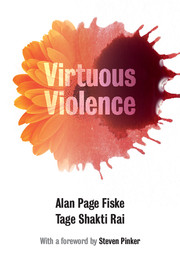Book contents
- Frontmatter
- Dedication
- Contents
- Figures and tables
- Foreword
- Warm thanks
- The point
- 1 Why are people violent?
- 2 Violence is morally motivated to regulate social relationships
- 3 Defense, punishment, and vengeance
- 4 The right and obligation of parents, police, kings, and gods to violently enforce their authority
- 5 Contests of violence: fighting for respect and solidarity
- 6 Honor and shame
- 7 War
- 8 Violence to obey, honor, and connect with the gods
- 9 On relational morality: what are its boundaries, what guides it, and how is it computed?
- 10 The prevailing wisdom
- 11 Intimate partner violence
- 12 Rape
- 13 Making them one with us: initiation, clitoridectomy, infibulation, circumcision, and castration
- 14 Torture
- 15 Homicide: he had it coming
- 16 Ethnic violence and genocide
- Chapter 17 Self-harm and suicide
- 18 Violent bereavement
- 19 Non-bodily violence: robbery
- 20 The specific form of violence for constituting each relational model
- 21 Why do people use violence to constitute their social relationships, rather than using some other medium?
- 22 Metarelational models that inhibit or provide alternatives to violence
- 23 How do we end violence?
- 24 Evolutionary, philosophical, legal, psychological, and research implications
- The dénouement
- References
- Index
16 - Ethnic violence and genocide
Published online by Cambridge University Press: 05 December 2014
- Frontmatter
- Dedication
- Contents
- Figures and tables
- Foreword
- Warm thanks
- The point
- 1 Why are people violent?
- 2 Violence is morally motivated to regulate social relationships
- 3 Defense, punishment, and vengeance
- 4 The right and obligation of parents, police, kings, and gods to violently enforce their authority
- 5 Contests of violence: fighting for respect and solidarity
- 6 Honor and shame
- 7 War
- 8 Violence to obey, honor, and connect with the gods
- 9 On relational morality: what are its boundaries, what guides it, and how is it computed?
- 10 The prevailing wisdom
- 11 Intimate partner violence
- 12 Rape
- 13 Making them one with us: initiation, clitoridectomy, infibulation, circumcision, and castration
- 14 Torture
- 15 Homicide: he had it coming
- 16 Ethnic violence and genocide
- Chapter 17 Self-harm and suicide
- 18 Violent bereavement
- 19 Non-bodily violence: robbery
- 20 The specific form of violence for constituting each relational model
- 21 Why do people use violence to constitute their social relationships, rather than using some other medium?
- 22 Metarelational models that inhibit or provide alternatives to violence
- 23 How do we end violence?
- 24 Evolutionary, philosophical, legal, psychological, and research implications
- The dénouement
- References
- Index
Summary
Historically, CS unity and AR hierarchy moral motives may become connected to caste systems, in which the moral order is crucially constituted by preserving the CS essence of a high caste from degrading pollution by the substance of a lower caste. In some caste systems, the high caste is polluted if they eat or drink or share comestibles with low-caste persons, or eat food prepared by low-caste persons. In South Asia, the American South, and other caste systems, the collective corporeal purity of the high caste is perceived to be fundamentally polluted if a high-caste woman has sexual relations with a low-caste man. In these moral systems, “miscegenation” is a grave threat to the CS integrity of the high caste and at the same time a violation of its superior social status. This CS unity morality may motivate lynching of low-caste men, and, at its most extreme, it can generate mass killing and genocide.
Violence against African-Americans in the US South
In the US South, “Negro” disrespect to any white person, or, far worse, dishonoring the purity of a white woman, justified immediate lynching (Black, 1998: 152–3). Most whites regarded “Negroes” as a degraded kind who had to be kept in their place, and the sexual potency of Negro men was a particular threat to the purity of white women and hence to the honor of white men (Graves, 1906). Negro men accused of violence against any white, or of even the slightest sexually tinged communication with a white woman, were typically lynched, and this might involve burning alive or otherwise torturing to death (Clark, 1998; Godshalk, 2000). Often a large, appreciative, and encouraging audience of respectable citizens assembled to enjoy the show and then to vie for souvenir body pieces. For example, in 1899, after being accused of killing his employer and sexually assaulting the man’s wife, Sam Hose was chained to a stake, his ears and fingers were sliced off and tossed to the audience, his tongue was removed with pliers, and he was then doused in coal oil and set on fire. White men then butchered his charred corpse and sold pieces as souvenirs to the audience of 2,000 who had arrived by special excursion train.
- Type
- Chapter
- Information
- Virtuous ViolenceHurting and Killing to Create, Sustain, End, and Honor Social Relationships, pp. 206 - 215Publisher: Cambridge University PressPrint publication year: 2014

